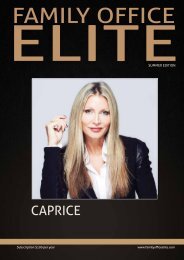Family Office Elite Spring_16
Family Office Elite Magazine, the wealthiest audience in the world. Family Office Elite Magazine is a very high class bespoke publication and a porthole to the ultra-wealthy family offices and UHNWI sectors. The magazine includes editorials from recent events and experts from the ultra-wealthy Family Office community.
Family Office Elite Magazine, the wealthiest audience in the world.
Family Office Elite Magazine is a very high class bespoke publication and a porthole to the ultra-wealthy family offices and UHNWI sectors. The magazine includes editorials from recent events and experts from the ultra-wealthy Family Office community.
You also want an ePaper? Increase the reach of your titles
YUMPU automatically turns print PDFs into web optimized ePapers that Google loves.
to control where their money goes.’ These ideas were<br />
underlined by a Dutch philanthropist and social investor<br />
interviewed for the book, who said that ‘social impact is<br />
new for our family. It combines two things - doing good,<br />
and you can reuse money multiple times. We are an<br />
entrepreneurial family, so we like the entrepreneurial<br />
logic, the discipline, and rigour. With a social impact<br />
approach, you become co-owner rather than just<br />
donor’. But there are nuances, and this philanthropist<br />
is not solely interested in impact; his motivations mix<br />
giving with the measures of efficiency that impact<br />
offers. ‘Social impact is a complement to [traditional]<br />
donations. We have been an impact-first social investor<br />
for a long time.’<br />
IMPACT, THE PROFESSIONAL APPROACH<br />
Impact could be a way of expressing your professional<br />
status – ‘professionalism through impact measurement’<br />
as Serge Raicher, co-founder of EVPA expresses it.<br />
Funders, fundraisers, and staff in the field have ‘become<br />
more professional,’ says Arnout Mertens, General<br />
Director of Support Services at Salvatorian Fathers and<br />
Brothers in Rome. ‘We are moving away from charity<br />
to impact. Governments are imposing more stringent<br />
rules. They don’t fund without a needs assessment,<br />
and if we don’t have a financial [management] manual<br />
in place then the project does not get the grant. We<br />
need three quotes for bills of quantity - in places where<br />
even basic literacy may be a problem. There are visits<br />
from funding organisations, financial audits… There has<br />
been a significant change in funder attitudes over the<br />
past two years.’ Arnout debates the practicality of all<br />
of this. Salvatorian Fathers and Brothers work in what<br />
he describes as ‘forgotten places’ – the lost villages of<br />
the Global South. Data gathering, reliable monitoring,<br />
long-term impact evaluation are all very hard to achieve<br />
when there is no electrical power, no or few literate<br />
adults and the constant threat of natural or human<br />
disaster.<br />
That view is seconded by Marie-Stéphane Maradeix,<br />
CEO (Déléguée générale) of the Fondation Daniel et<br />
Nina Carasso, a philanthropic foundation based in Paris<br />
and Madrid which derives from the family that owned<br />
Danone, the dairy foods company. She illustrates the<br />
difficulties and contradictions inherent in measuring<br />
philanthropy; ‘There is a real demand [amongst<br />
philanthropists] to understand impact. They are used to<br />
working with KPIs [Key Performance Indicators]. When<br />
[the foundation board] interviewed me [for this job]<br />
they asked me about KPIs. I said that the foundation<br />
was working with complex social and/or cultural issues<br />
which are not always measurable in the way that an<br />
industrial product can be measured. Measuring social<br />
impact needs a long-term vision that is not always<br />
compatible with short-term projects.’<br />
INVESTMENT, SUSTAINABILITY, AND IMPACT<br />
Impact is part of a convergence of ideas. It has emerged<br />
as the basis for a class of investment. Investment<br />
with impact – that creates both financial and social or<br />
environmental value – is a fast growing class of assets.<br />
The annual J.P. Morgan/Global Impact Investing Network<br />
(GIIN) survey of the sector for 2015 (Saltuk, 2015)<br />
reports a 7% growth in capital committed between<br />
2013-2014 and a 13% growth in the number of deals,<br />
with survey respondents managing a total of US$60<br />
billion in impact investments.<br />
Through the growth of impact investments more and<br />
more people were arguing that every investment has<br />
an impact, the only questions are weather this impact<br />
is positive or negative. And many people would argue<br />
today that we are at a point in human history, where we<br />
cannot afford more investments with negative impact.<br />
FOUNDATIONS OF IMPACT<br />
Foundations in Europe seek impact in their grantmaking,<br />
but they are increasingly also seeking it in<br />
their investments. This is a radical departure for a<br />
foundation sector in Europe that has, for years, focused<br />
only on the financial, and not on the social returns from<br />
its investments. That requirement was laid down in<br />
regulations – until 2011, for example, the UK Charity<br />
Commission guidance to trustees was to maximise<br />
financial returns. In that year, the Commission issued<br />
new guidelines ‘on investments that help the charity<br />
to achieve its mission where this has no significant<br />
financial detriment (mission related investment)’. This<br />
new guidance allowed foundations in the UK to make<br />
impact investments. As is often the case, the US had<br />
WWW.FAMILYOFFICEELITE.COM<br />
102



